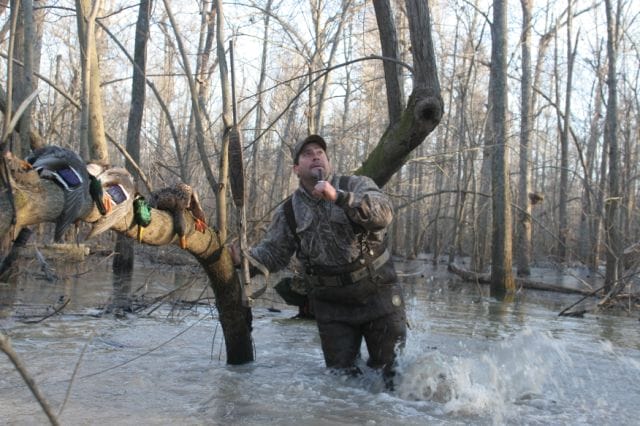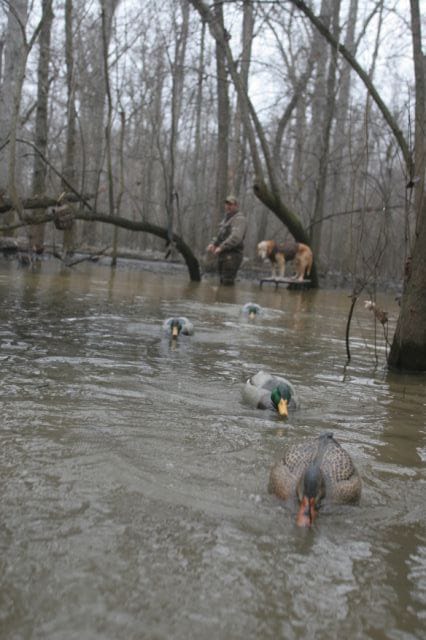by David Hart
The sight of a dozen mallards filtering through the treetops as their wings slapped against limbs was unlike anything I’d seen before.

Shooting mallards in the flooded timber is classic duck hunting, the type that will make a hunter a lifetime waterfowling addict.
I stood mesmerized by the sight, by the very notion that ducks would willingly land in a flooded forest. When Keith Allen called the shot, I never even lifted my gun.
The two of us were standing thigh-deep in a flooded oak forest in northeastern Arkansas as thousands of mallards crossed back and forth just above the treetops. Each time a flock passed by, Allen would cut loose on his call. Some ducks turned for another look and a few glided toward the brown water and offered us shots; most continued on their way. That’s the way it is in a typical timber duck hunt, although hunting mallards in green timber is anything but typical.
Find The X
All duck hunters understand the importance of parking over the mythical “X,” the exact spot ducks want to be in, no matter what. Just as field hunters spend countless hours cruising farm country in search of birds feeding in fields, timber hunters are wise to do the same.
“I’ll scout for hours if that’s what I need to do to find ducks,” says Allen, brand manager for Banded Calls. “I want to be where the ducks are instead of trying to bring the ducks into a spot they may not want to land.”
That’s not to say you can’t kill ducks in timber by randomly throwing out a small decoy spread. You just need to find the right spot.
Hunt The Holes
If you can’t find a concentration of ducks on the water but plenty of birds are crossing above the tree tops, look for an opening in the forest. You don’t need to find a gaping, treeless hole the size of a football field. You don’t even need an obvious opening, although those spots can be productive. Allen prefers more subtle openings in the forest canopy, openings that many duck hunters never see.

Shaking a leg to move the water can be very effective at attracting the attention of wary ducks when you’re hunting in the timber.
“All I need is a tree lying down. That’s often enough to create an opening big enough for ducks to land in. The obvious bigger holes in the timber attract a lot of hunters, and I want to avoid that,” he says. “I also look for slots or landing chutes in the trees, especially a slot that runs in the same direction as the wind. That makes it easier for birds to land right where I want them to land.”
Bring ’em Alive
Once he finds the physical ingredients he’s looking for, Allen simply tosses out a few decoys. He’s not a fan of big spreads and rarely uses more than a dozen mallard decoys, mostly drakes because they are more visible from treetop level. A big spread just isn’t necessary, he insists. What matters more is motion.
“I use a jerk cord on my decoys, and I’ll kick the water when I’ve got ducks working,” he explains. “Ducks cruising above the tree tops need to see the ripples on the water to get their attention. Once they see some commotion down below them, they’ll turn for another look.”

A jerk cord, where decoys are attached to a cord the hunter can pull, adds movement to the water. These ripples are what flying ducks expect to see when live ducks are on the water.
Hit ’em Hard
That’s when Allen, a three-time World Champion Duck Calling Contest finalist, lays on his Banded Classic Series Timber Duck Call. Instead of blowing a few random high-balls, the Missouri native only calls when the birds are either going away or about to turn towards the hole. Calling at the exact right time can mean the difference between ducks and no ducks.
Allen essentially tries to lead the birds into the landing zone through calculated calling. He won’t call when the ducks are moving in the right direction (towards him, for example), but he’ll hit them with loud, aggressive calling when they seem to be moving away. Once the ducks seem committed, he’ll back off and finish the sequence with soft feeding chuckles and plenty of motion.
Expect Competition
Coaxing ducks through the forest can be a sure thing if you hunt private land. Unpressured birds always respond better to decoys and calls than birds that have been worked hard. Public land? Expect flared birds, encroaching hunters and a generally tougher hunt. Birds circling your spread may get spooked by distant shooting, or nearby hunters may take a treetop-level shot at the birds working your spread. It’s frustrating, but there’s not much you can do about it.
One of the best ways to avoid the crowds is to hunt as far away from boat landings and access points as possible. Ironically, however, some hunters do just the opposite: They hunt relatively close to the boat ramp under the assumption that everyone wants to get away from the parking lot. It can work, but remember, it’s green timber duck hunting—fun, frustrating or flat-out exciting when the birds work right. Just remember to shoot.
The Union Sportsmen’s Alliance website is designed to provide valuable articles about hunting, fishing and conservation for members of AFL-CIO affiliated labor unions and all sportsmen and sportswomen who appreciate hunting and fishing and want to preserve our outdoor heritage for future generations. If you would like your own story and experience from the outdoors to be considered for our website, please email us at USAmembers@unionsportsmen.org.



